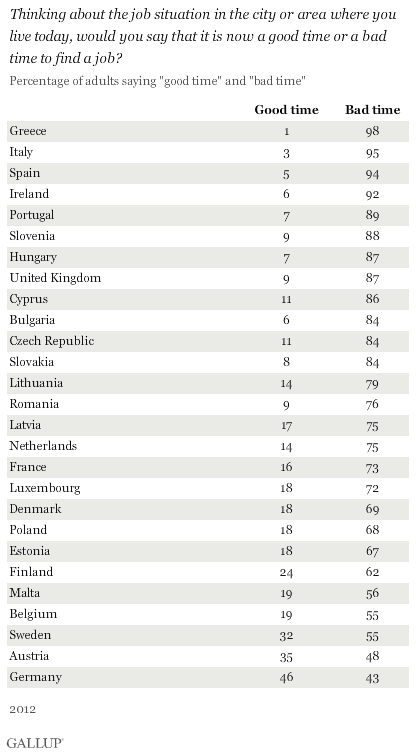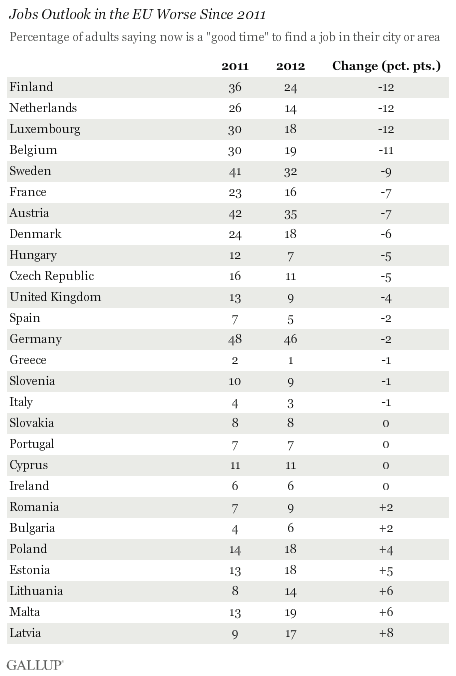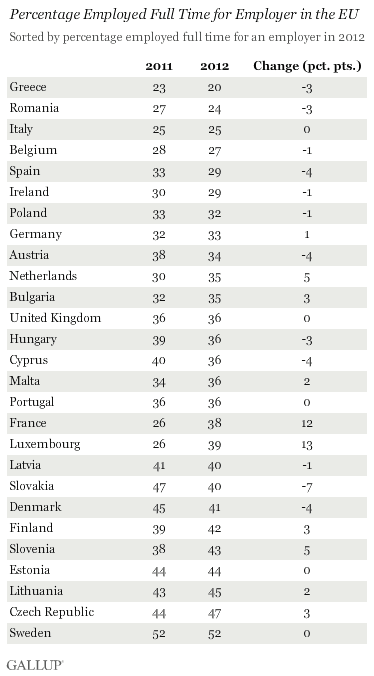BRUSSELS -- Amid rising unemployment, the jobs outlook across the European Union is deteriorating in 2012. Majorities in all EU countries except Germany and Austria -- where unemployment rates are among the lowest in the eurozone -- say now is a "bad time" to find a job in the city or area where they live. Pessimism is nearly universal in Greece, Italy, Ireland, and Spain, where more than nine in 10 residents say it is a bad time to find a job.

The poor jobs outlook comes in the context of some of the highest unemployment levels ever seen in the EU. According to Eurostat, the EU's statistical agency, unemployment levels increased slightly in September, up from already record levels in August. Spain (25.8%), Greece (25.1%), and Latvia (15.9%) had the highest unemployment levels in the EU, followed by Portugal (15.7%), Ireland (15.1%), and Slovakia (13.9%), as reported by Eurostat. In most countries, unemployment rates have not improved since 2011.
Germany is the only country where people are more likely to say it is a good time (46%) rather than a bad time (43%) to find a job, and even they are divided. In Sweden and Austria, where approximately one in three say it is a good time to find a job, residents are also more optimistic than other Europeans. In all other EU countries, however, fewer than one in four say it is a good time to find a job. In comparison, 28% in the U.S. and 43% in Canada say it is a good time to find jobs.
Additionally, the jobs outlook across the EU has gotten significantly worse since 2011: The percentage of those who think it is a good time to find a job has decreased in many countries. The greatest statistically significant decreases occurred in Finland, the Netherlands, Luxembourg, Belgium, Sweden, France, Austria, Denmark, Hungary, the Czech Republic, and the United Kingdom, many of the countries that had relatively better outlooks in 2011.
There were, however, slight improvements in Latvia and Estonia from 2011, but the percentages of those who think it is a good time to find a job remains below 20% in both of these countries.

Few in Greece, Romania, Italy Hold Full-Time Jobs for an Employer
Despite the growing pessimism, Gallup's Payroll to Population measure -- which estimates the percentage of the total population that is employed full time for an employer -- has remained relatively stable in most countries in 2012. However, many countries where the jobs outlook is grim -- Greece, Romania, Italy, Belgium, Spain, and Ireland -- have the lowest percentage of full-time employees for an employer per total population in the EU. In each of these countries, less than 30% of the adult population is employed full time for an employer.

Sweden is the only country in the EU where the majority of the population is employed full time for an employer (52%). In comparison, 45% of the adult population in the U.S. is employed full time for an employer -- similar to the rates in the top five EU countries.
Bottom Line
Large majorities in most EU countries continue to think that now is a bad time to find a job, with the situation in some countries, including Greece and Italy, dire as almost all residents say it is a bad time to find a job.
In much of southern Europe, Payroll to Population rates are below 30%, meaning that less than a third of the adult population is contributing to the country's economy in a full-time capacity. This signals a problem that goes beyond high unemployment to longer-term problems with the sustainability of economic growth. It also points to the problem that many of these countries are facing with increasing taxes on a shrinking base of taxpayers.
For complete data sets or custom research from the more than 150 countries Gallup continually surveys, please contact us.
Survey Methods
Results are based on face-to-face interviews or phone interviews with approximately 1,000 adults, aged 15 and older, per country per year. Interviews in 2011 and 2012 were conducted in 27 EU member states. For results based on the total sample of national adults, one can say with 95% confidence that the maximum margin of sampling error ranges from ±2.2 percentage points to ±3.8 percentage points. The margin of error reflects the influence of data weighting. In addition to sampling error, question wording and practical difficulties in conducting surveys can introduce error or bias into the findings of public opinion polls.
For more complete methodology and specific survey dates, please review Gallup's Country Data Set details.
